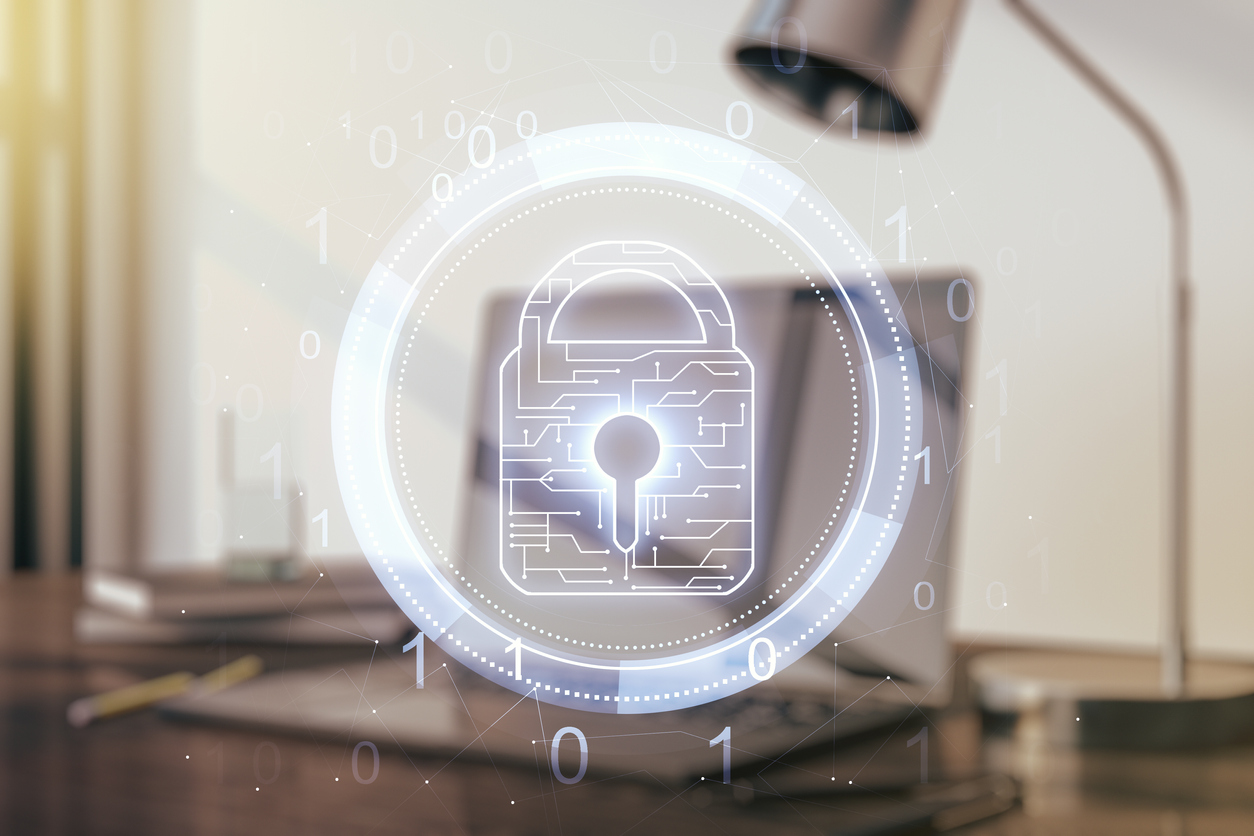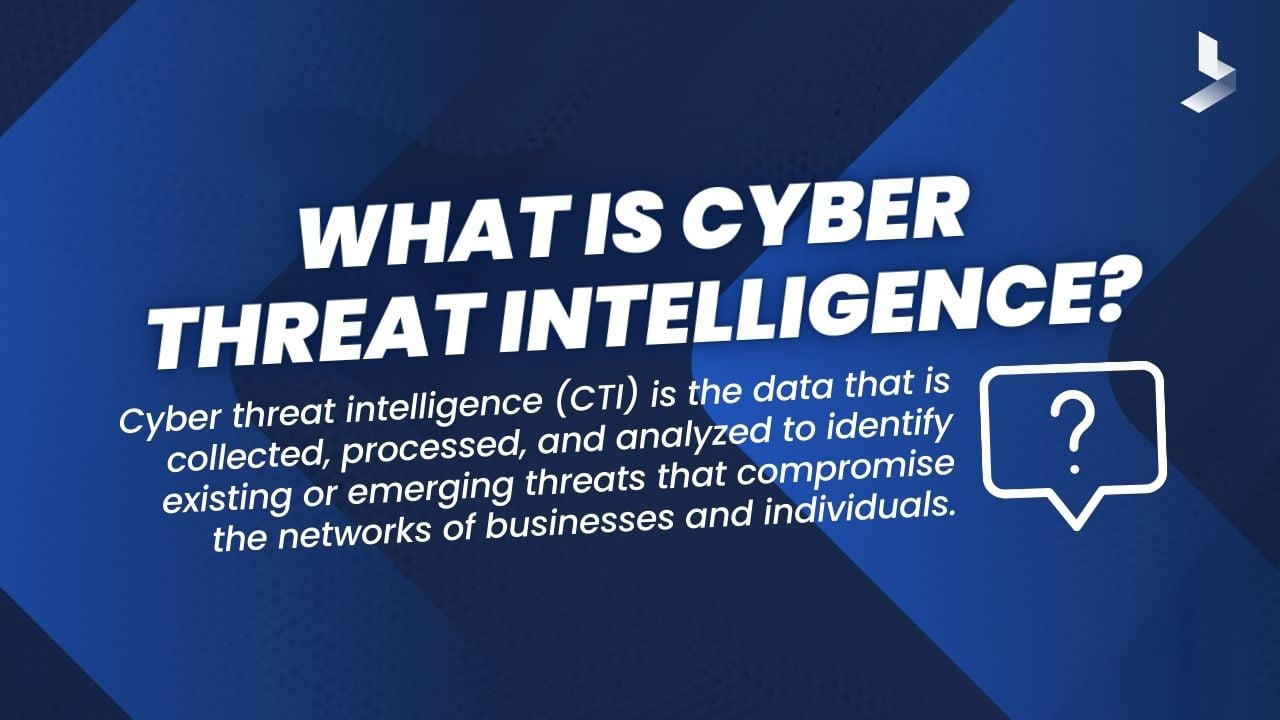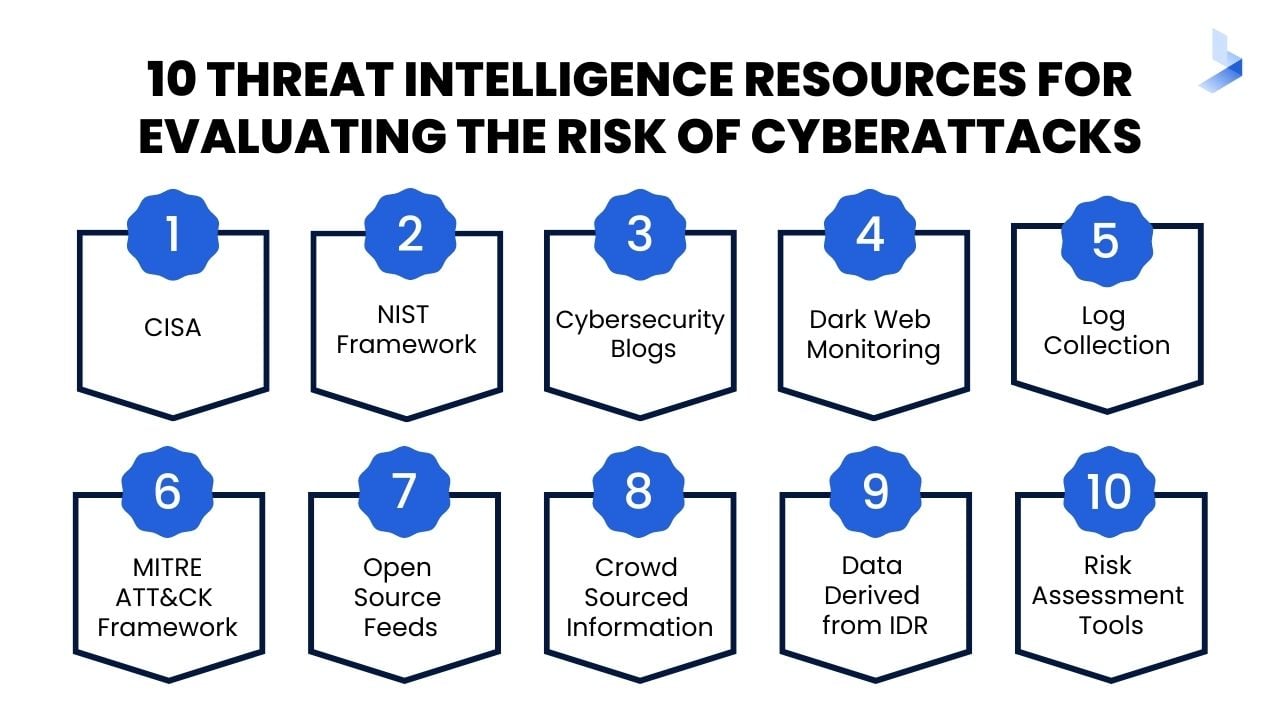10 Threat Intelligence Resources for Evaluating Cyber Risk

 By
Emily Miller
·
8 minute read
By
Emily Miller
·
8 minute read
Cyber threats are growing in both number and complexity. While this growth puts businesses of all sizes at risk, cybersecurity professionals continually utilize ongoing education and modern technology to stay ahead. The abundance of data, cyber threat intelligence, and security solutions is making it easier than ever to identify potential cyberattacks. However, security professionals must also keep pace with the fast-changing nature of cyber threats.
Whatever your role within an organization, you should be able to recognize potential cybersecurity risks before they become a problem. There is no one way to do this—everyone has a different set of skills and knowledge—but there are various resources that can help you evaluate the risk of a cyber attack on your organization. To effectively utilize threat intelligence resources, it's important to understand exactly what cyber threat intelligence is and the role different types of data play in a complete cybersecurity solution.
What is Cyber Threat Intelligence?
Cybersecurity professionals use various tools and procedures to identify cyber threats and attacks. Cyber threat intelligence (CTI) is the data that is collected, processed, and analyzed to identify existing or emerging threats that compromise the networks of businesses and individuals. Such evidence includes indicators of compromise (IOC) including potential vulnerabilities, the behaviors of threat actors, and the tools and techniques used to perform modern, sophisticated cyberattacks. The information is collected from a continuous stream of data derived from internal and external sources.

CTI is the backbone of every cybersecurity solution because it provides relevant information about how attacks are launched and carried out. With this knowledge, IT and cybersecurity professionals can better devise ways to prevent cyberattacks or halt attacks in progress. Threat intelligence can be derived from external sources that provide information about existing threats and internal sources that keep professionals informed about the activities occurring within a business network. Internal threat intelligence typically comes from sources like event and application logs, firewall logs, DNS logs, and other sources that log network activity. External threat intelligence can be derived from a variety of sources that are publicly available, like cybersecurity blogs, news reports, public block lists, and private commercial sources provided by cybersecurity vendors.
Cyber threat intelligence resources come from a variety of sources, including those that monitor the activity of criminal behavior and data from your organization's cybersecurity events.

10 Threat Intelligence Resources to Evaluate Cyber Risk
In the past, cybersecurity resources were primarily reactive. To protect against modern sophisticated cyberattacks, businesses need the inside track to information about what makes their network vulnerable to attack. To accomplish this, IT teams, business leaders, and cybersecurity professionals utilize various resources to increase their knowledge about cybersecurity threats and create comprehensive cybersecurity solutions.
1. CISA
For businesses unsure about their cybersecurity hygiene or those looking for a comprehensive way to learn about the dangers of modern cyber threats and effective security solutions, CISA is a good place to start. The Cybersecurity and Infrastructure Security Agency, better known by its acronym, CISA, provides insights and releases about current cybercrime events.
With information that ranges from recent patches to in-depth analysis of malware and threat actors, businesses can better protect their networks against known threats. CISA also keeps an updated Known Exploited Vulnerabilities Catalogue that provides immediate access to information about vulnerabilities.
2. NIST Framework
The NIST Cybersecurity Framework is a comprehensive approach to security designed to help businesses better understand and manage their risk. The National Institute of Standards and Technology is an agency that is part of the U.S. Department of Commerce. The framework created by the agency is often used by government agencies and contractors and is the framework most used for regulatory standards.
Whether businesses are seeking ways to develop a comprehensive cybersecurity plan or preparing to meet new compliance regulations, the NIST framework lists multiple strategies and methods for managing cybersecurity risks.
3. Cybersecurity Blogs
Cybersecurity vendors provide businesses with a variety of different services and products to protect against cyber threats. To effectively provide these services, these professionals are extremely experienced and highly educated in the risks associated with modern cyber threats. Many of these companies host up-to-date cybersecurity blogs that detail current events, new threats, and updated systems and methods to protect against such threats. By following cybersecurity blogs, business leaders and IT professionals can gather important information to advance their cybersecurity efforts.
| Related Reading: Our Favorite Resources for Developing Cybersecurity Skills |
4. Dark Web Monitoring
While most people have heard of the dark web and know it is an online destination for criminal activity, many have little knowledge of how it's accessed and used. The dark web is part of the internet, but it isn't visible to search engines and requires the use of an anonymizing browser called Tor for access. While it's somewhat comforting to know that the dark web isn't indexed by search engines, the Tor browser can be downloaded for free as a privacy tool. Other browsers can also be used to access the dark web, but Tor is the most well-known for use because of its high-level anonymity.
Dark web monitoring is the process of searching for and tracking information about your organization on the dark web. Dark web monitoring tools are similar to tools used to monitor typical search engines. They continually search the dark web and pull in raw intelligence in real-time. Instead of attempting to research every piece of information on the dark web, sites are monitored for specific information like corporate email addresses or general information like the company name and industry.
Targeted dark web monitoring typically captures information about a specific company or industry. The data derived from monitoring can be used in different ways to mitigate threats.
- Threat Intelligence: Data captured by dark web monitoring can include information about new threat vectors or widespread vulnerabilities. This information can be fed into automated threat intelligence systems and added to open-source lists.
- Threat Hunting: Information derived from dark web monitoring can provide vital data to speed threat-hunting efforts and offer an understanding of the methods applied by hackers.
- Integration into Security Platforms: Data collected from dark web monitoring can be added to security platforms that use machine learning for automated detection and response. When this new information is added to security tools, users will receive alerts when threats are detected, and automated response systems can respond to effectively help mitigate the threat.

5. Log Collection with Network Monitoring Tools
Complete visibility into all of the activities that occur within an organizational network is essential to providing effective cybersecurity. While perimeter protection tools like firewalls are designed to keep hackers out, vulnerabilities and human activities can allow unexpected breaches that evolve into major attacks. Modern sophisticated cyberattacks employ discreet methods like phishing and impersonation to allow hackers to access a network and pose as legitimate users while advancing through the network. Tools that monitor user activities and collect relevant data can generate vital threat intelligence about cyberattacks.
Network monitoring tools generate logs that describe user activities, system performance, IoT activity, transfers of data, and more. When context is added to the data from these tools, internal CTI can be used to gather insight into cyberattacks in various ways.
- Suspicious Behavior on the Network: When ML is applied to next-gen network monitoring tools, the system categorizes baseline behavior as normal. When legitimate system users appear to take actions outside of the typical baseline, these tools flag the behavior as suspicious. This type of internal information provides critical insight into the early stages of attacks that take advantage of compromised credentials and can be used to quarantine compromised devices and take other actions to halt an attack before the hacker reaches their objective.
- System Glitches that Indicate Compromise: Network monitoring tools are also used by IT professionals to ensure systems are running seamlessly. When systems perform erratically, the information provided by these unusual activities can reveal indicators of compromise (like redirected internet searches, email errors, random popups, and failed passwords).
6. The MITRE ATT&CK Framework
While the NIST framework is used to apply best practices for effective cybersecurity, MITRE ATT&CK provides information about the methods cybercriminals use in different attacks. The globally accessible knowledge base includes adversary tactics and techniques based on real-world observations. With over 350 use cases mapped to specific techniques, the knowledge is often used by IT teams and cybersecurity experts to pinpoint network risks and focus cybersecurity efforts on recognizable threatening behavior. This knowledge is typically used alongside cybersecurity tools for an efficient cybersecurity solution.
7. Open Source Feeds
Open-source threat intelligence platforms make use of threat intelligence data derived from publicly available open sources. Since it's impossible for any one team to keep up with the constant stream of data surrounding modern cyber threats, security forums and dedicated national and international security lists provide a way for various professionals and volunteers to pool knowledge.
Open-source threat feeds are automatically updated and continually add new information. By following reputable feeds, businesses can stay up to date on new cybersecurity information.
8. Crowd Sourced Information from Cybersecurity Vendors
Cybersecurity vendors often provide comprehensive cybersecurity services to many businesses. Such services may include log collection, incident response, threat hunting, and more. These activities generate a wealth of information about potential vulnerabilities and new threats. This information can be combined with external threat feeds to enhance an organization's protection against evolving risks.
For example, here at BitLyft, we utilize threat information from all users and clients on the platform as well as outside sources, to validate threats as real and useful. We then add the information to our central threat intelligence warehouse to automatically provide proactive protection for each client.
9. Data Derived from Incident Detection and Response
An organization's processes and technologies for detecting and responding to cyber threats, security breaches, or cyberattacks are referred to as incident detection and response. While the foremost goal of cybersecurity is to avoid attacks, it's not always possible. Human error, zero-day attacks, and other vulnerabilities always have the potential to lead to an attack. That's why incident detection and response is a critical part of any cybersecurity solution.
The four key phases of incident detection and response (IDR) include preparation, detection and analysis, containment and eradication, and post-incident recovery. Threat intelligence is used in the detection phase of IDR. It also produces additional threat intelligence data, used in the recovery and follow-up phase, vital to improving cybersecurity hygiene and eliminating vulnerabilities.
Incident detection and response analyzes data from both internal sources like application logs and external sources like known threats and vulnerabilities which is used to launch automated responses. The entire process also generates vital information about the tools, techniques, and procedures (TTP) used by bad actors.
- Log Collection and Analysis: A vital part of any cybersecurity system, SIEM systems collect data about your network from multiple sources. The system uses machine learning (ML) to identify typical behavior within a network and alert to behavior that falls outside of the established baseline of normal. Next-gen SIEM can also use ML to utilize tactical threat intelligence to recognize and flag suspicious actions or TTP that is often used in cyberattacks. For example, Securonix SIEM, implemented as part of BitLyft Air, utilizes information from both the MITRE ATT&CK framework and central threat intelligence from all clients on the platform to automatically identify known criminal methods and activities. In other words, SIEM uses threat intelligence collected from multiple sources to automatically detect and respond to threats.
- Feedback to Improve IDR: Post-breach response is a vital part of any IDR procedure. An organizational network constantly generates data. The software and tools used to automate detection and response also generate important data. By examining this data, cybersecurity professionals can understand where the breach was initiated, the methods used by hackers to carry out the attack, and the ways the system could have worked differently to prevent an attack. By adding this new CTI to the system, the organization's cybersecurity posture is improved.
10. Risk Assessment Tools
Any network that accesses the internet could be a target for cyberattacks. Risk assessment tools help organizations understand, control, and mitigate various forms of cyber risk. By getting a firm understanding of the vulnerabilities in your organization's network, you can better assess your risk for different types of cyberattacks. The most common network assessment tools detect vulnerabilities in your system or those presented by third-party partners.
While external CTI is typically used to identify existing vulnerabilities, risk assessment tools also generate internal CTI that can help organizations recognize how threats affect the individual network. These are the most common processes performed by risk assessment tools
- Vulnerability Assessment: Vulnerability scanners perform high-level automated tests that search for known vulnerabilities in your system, and report them. The intelligence collected from these scans can be used for patch applications, updates, and other preventative actions to avoid attacks.
- Penetration Test: A penetration test also searches for weaknesses within your network, but it is a test performed by a cybersecurity professional that simulates an attack. Penetration tests can reveal vulnerabilities that aren't already cataloged on databases and the specific ways attackers can turn vulnerabilities into full-scale attacks. Pen testing reveals existing vulnerabilities as well as potential flaws in an organization's cybersecurity response.
- Third-Party Risk Assessment: Practically all businesses depend on third-party software to carry out daily business threats. Since popular software is used by thousands (if not millions) of businesses, it presents an attractive target for cyberattackers. Third-party risk assessments help organizations identify vulnerabilities presented by the third-party software they use and how to eliminate such vulnerabilities.
Hackers use automated tools, dark web forums, and even open-source data to find vulnerabilities they can exploit to hack organizational networks. Cyber threat intelligence is the information used to create effective defenses against these highly educated and capable threat actors. Yet, as you can see, the collection and use of cyber threat intelligence is a complex process that requires considerable time and expertise.
BitLyft Air is advanced Next-Gen XDR that utilizes the most up-to-date CTI for highly effective protection against modern cyberattacks. We combine highly effective software with a full-service off-site SOC to deliver organizations with the best of software and people to remediate most cyber threats in seconds. Request a demo to learn more about how BitLyft Air can provide unparalleled protection for your business.
